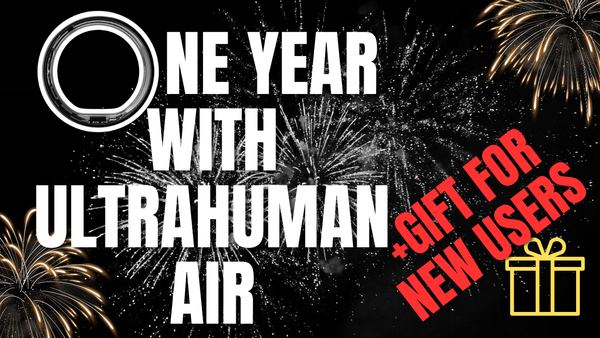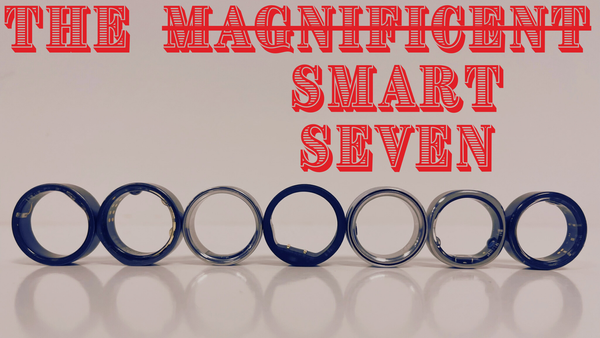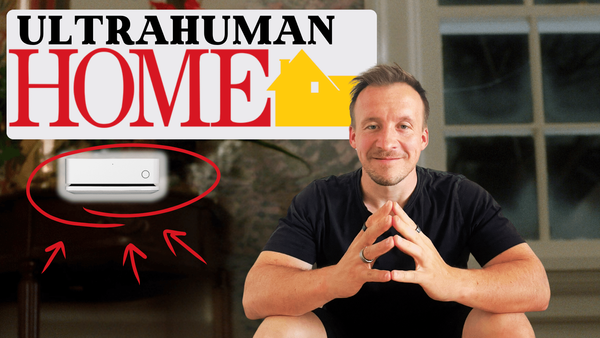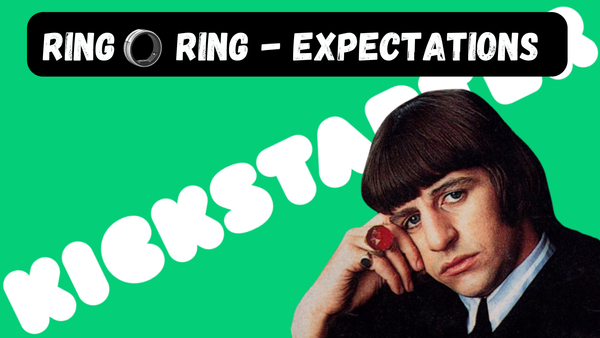Ultrahuman AIR — Review of the lightest smart ring
As part of a collaboration with the Ultrahuman team, I was given a new model of the Ultrahuman Smart Ring to test, called AIR, which is…
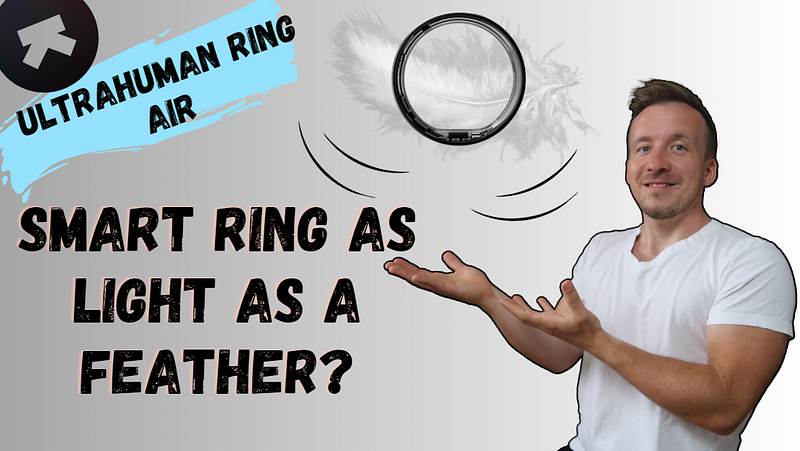
As part of a collaboration with the Ultrahuman team, I was given a new model of the Ultrahuman Smart Ring to test, called AIR, which is supposed to indicate that it is as light as air. I’ve set the scene for this review with the more critical article below:
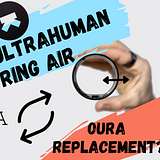
If you haven’t read it and don’t want to, I’ll summarise it by saying that I looked at this new product with some disdain and accused the Ultrahuman team of mostly deflating the big marketing bubble behind it, mainly by making the ring about $50 more expensive.
In this article, we’ll see if I’ve been proved right, or if I’ve been softened by the tinsel (free product to try).
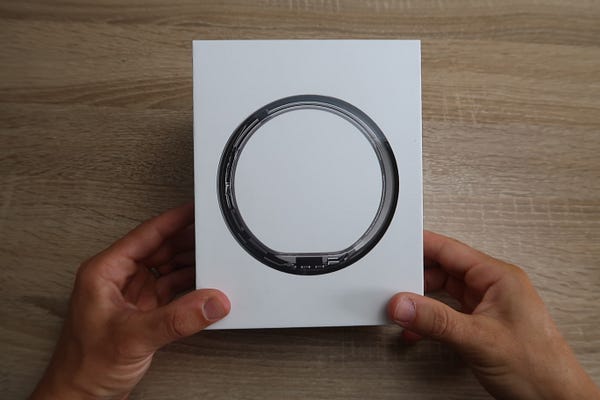
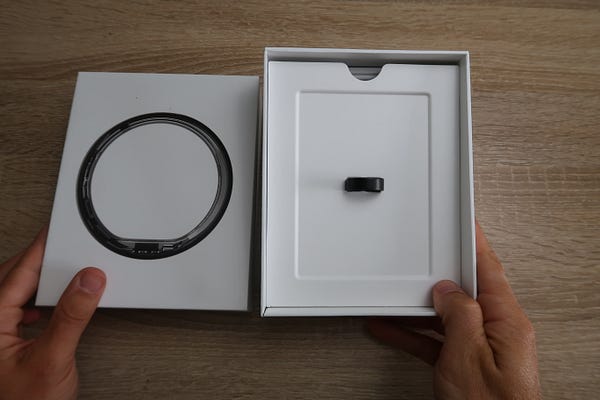
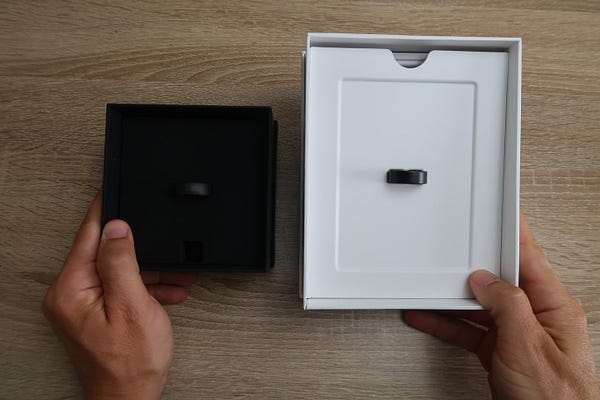
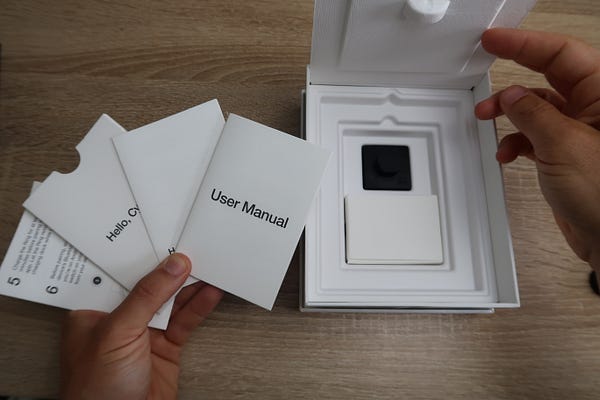
With the release of AIR, Ultrahuman has kind of broken my usual process of releasing a trio of articles on #smartrings, i.e. Expectations➜First Impressions➜Full Review. I’ve already published the first two articles on the now officially unsold Ultrahuman R1. The latter can only be found on Amazon, Ultrahuman only sells the AIR on their site, now only in the black matte version.
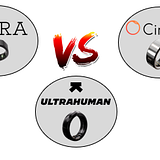
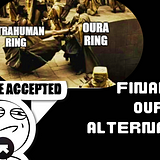
For completeness of context I recommend the optional articles above, however, this review will serve, I hope, independently of their knowledge. I will therefore review the new AIR, but will also list the differences with the old R1 for comparison.
I divide the main text, as usual, into hardware and software parts, within the HW there has been the main thing, the lightening and thinning of the ring body. However, even from the SW perspective Ultrahuman has not slowed down and the application has received changes and new functionalities.
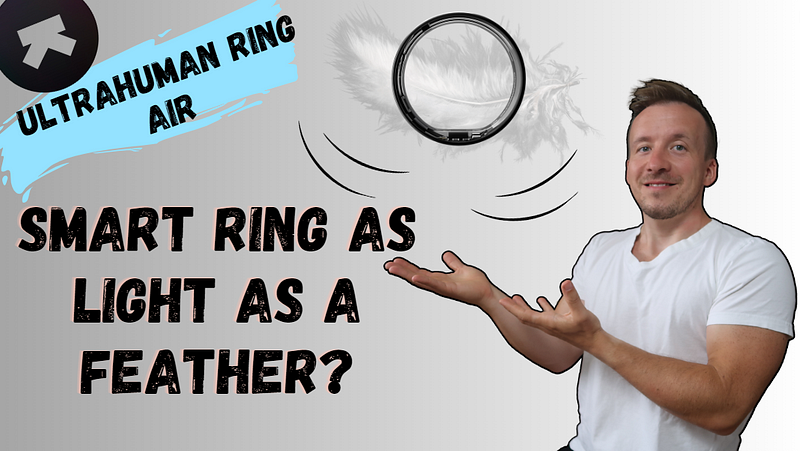
📈 The Ultrahuman ring needs a 2-week calibration period to be fully functional. I have already completed these with the R1, so all I had to do was disconnect it in the app and pair it with the AIR.
HW
Ultrahuman claims the AIR to be the world’s most comfortable and lightest ring. They even received a red-dot award for it. I have to confirm their claim after my tests. The R1 is already very comfortable to wear and I appreciate the de facto uniform inner smoothness of the ring, which you won’t find in the competition.
Like the R1, the outside of the AIR is coated with tungsten carbide for added scratch resistance. The R1 was definitely scratchable in my tests, but the grooves can be partially polished out.
Within the R1, I liked the lattice structure of the “top” of the outer ring shell. This has disappeared completely, making the ring completely round, such as the more premium Oura3 Horizon. With the disappearance of this structure, the ring has definitely gotten thinner, but the ring has lost the tangible ring position indicator. The correct rotation of the ring on the finger (sensors pointing inward) is more confidently checked visually.
Weight and dimensions
Air weighs 2.4–3.6g depending on the size. My Air size S09 weighs 2.84g, which is actually the lightest compared to similarly sized competitors (the RingConn is smaller, I wear it on my middle finger):
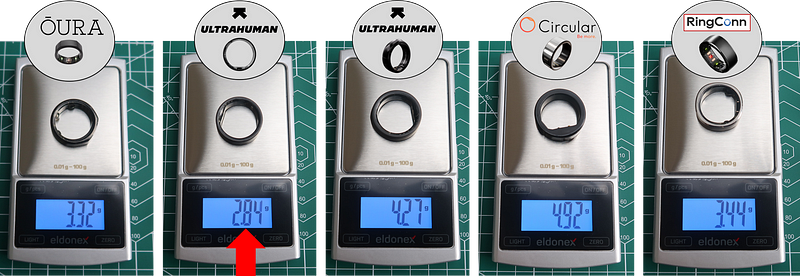
In terms of size, the situation is even tighter and the measurements more challenging. I measured the full width of the ring at the widest point (which slightly favours my smaller RingConn).

So the winner in this discipline is… Ultrahuman Air! Congratulations.
📏 In terms of size, the R1 and Air are interchangeable, i.e. the R1 size S09 fits exactly the same as the Air S09. However, I don’t think they are interchangeable with the Oura. So I would recommend getting the Ultrahuman sizing kit if you are considering a change.
Battery and charger
The Ultrahuman uses a 24mAh LiPo battery that takes about 1.5–2 hours to fully charge, wirelessly on a charger using a similar concept to the Oura. The battery life of the ring is 4–6 days on paper, depending on how you use the ring (for example, activating the workout mode will drain the battery more). From my tests so far, it’s more like 4 days before the battery drops below 20%, which is not desirable.
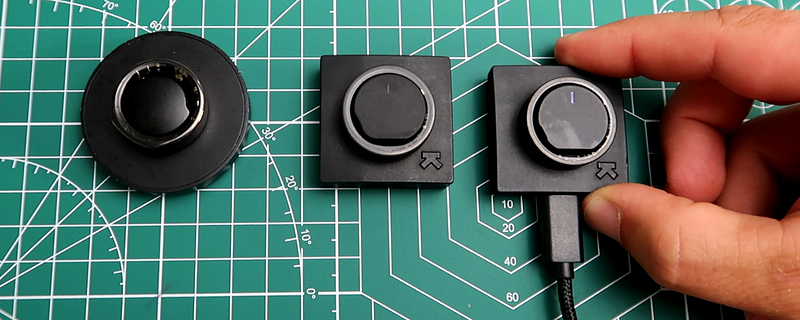
The charger is identical to the R1 (same size), so I’m going to criticise the same thing: the charger lights up even when the ring is not attached, which is not needed for me.
Sensors
The classic sensor suite includes an accelerometer, thermometer, infrared (for daily HR), red (HR and SPO2) and green (HR) optical sensor. Nothing has changed here compared to the “standard” and the R1.
HW [-] & [+]
[+] 👍
- low weight
- minimalist ring size
- matte finish
[-]👎
- the ring often requires a visual check of correct rotation of the ring
- still luminous charger
- currently only available in black
💰 Ultrahuman AIR can be temporarily cheaper. I have agreed on the following code with them. Thank you for using my link:
https://fitnesator.link/ultrahuman ULTRAHUMAN AIR 10% DISCOUNT CODE: FITNESATOR10
SW
The Ultrahuman application acts as a graphical interface to the company’s two products. It is a interface for the CGM sensor and, of course, a means to visualise the data measured by the ring.
Basic navigation
The basic navigation of the app has undergone some changes, with the disappearance of a tab in the footer that I thought was common to both the ring and the CGM sensor. Now each product has its own, with relevant information intertwined. The third tab contains videos, podcasts, workouts, etc. The fourth tab is for settings.
The app could probably be clearer, but I see it as still evolving, first used for the CGM, then for the ring, and now still optimizing.
The Ring tab offers tiles and a click-through to 3 basic sections — Sleep Index, Activity Index and Recovery Score. Each section is accompanied by verbal commentary.
Scrolling further will give you:
- Heart Rate [bpm] for the last few hours, with a click through to the curve and a change to the detail of daily/weekly and monthly HR averages,
- Skin temperature [°C] — similarly temperature for the last few hours, also with a click-through option,
- Average HRV for last night
- Timeline — with a record of all events.
I won’t list the details here, a picture will serve better.
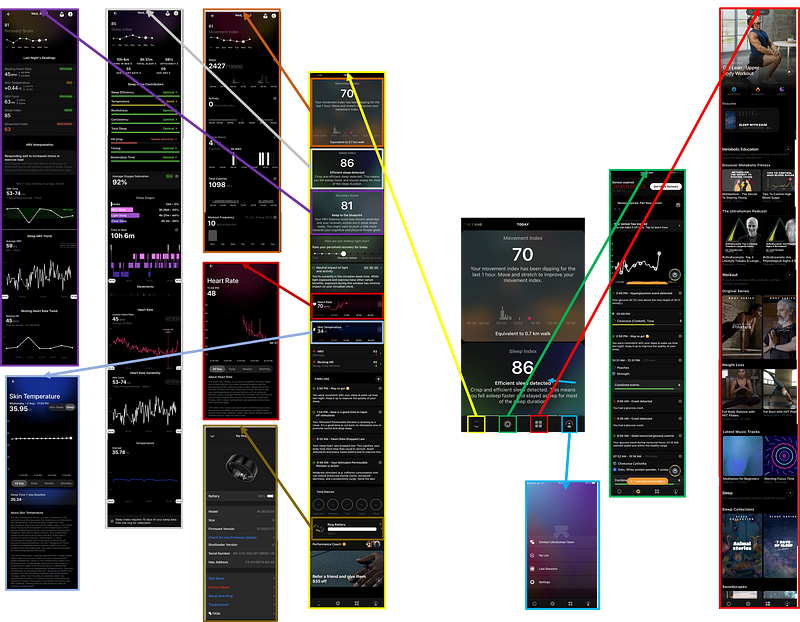
Activity/Movement Index
My original claim that Ultrahuman doesn’t work with isolated metrics would now be misleading. It is still the case that the Movement Index section mainly contains steps, MET (activity intensity per time), active time and calories.
You still won’t find activity in this tile, but you can find it in the timeline:
- View activities imported from elsewhere (e.g. iHealth)
- Start a workout — currently in beta.
The workout functionality is matched by Ultrahuman Oura, which also has this. Ultrahuman offers an even wider range of activities. If you have your phone with you and allow the app to access GPS, the activities will include a route map as well as HR and calories.
So the Ultrahuman ring can now be considered a workout tracker to some extent, unless you have a sports tester or other device on your wrist.

An interesting feature is Ultrahuman’s approach to calculating Movement Index scores. It is reset every morning to a default (highest/best) value of 100 and drops further if, simply put, you move little.
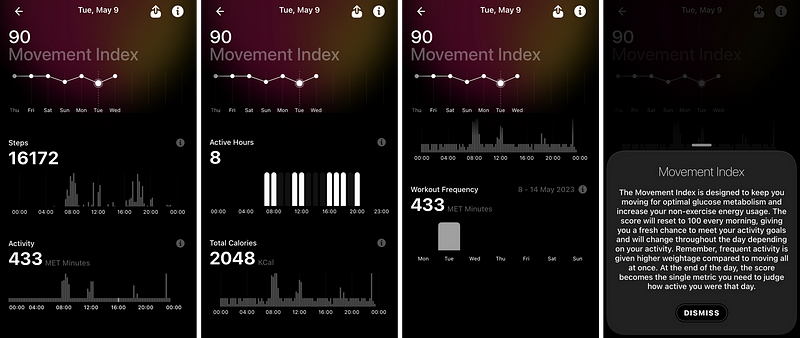
Recovery / Recovery Score
The Recovery Score is somewhat analogous to the Readiness Oura ring. -Which also implies that metrics play a primary role:
- Lowest Heart Rate,
- average HRV,
- temperature,
- and related attributes, see images below.
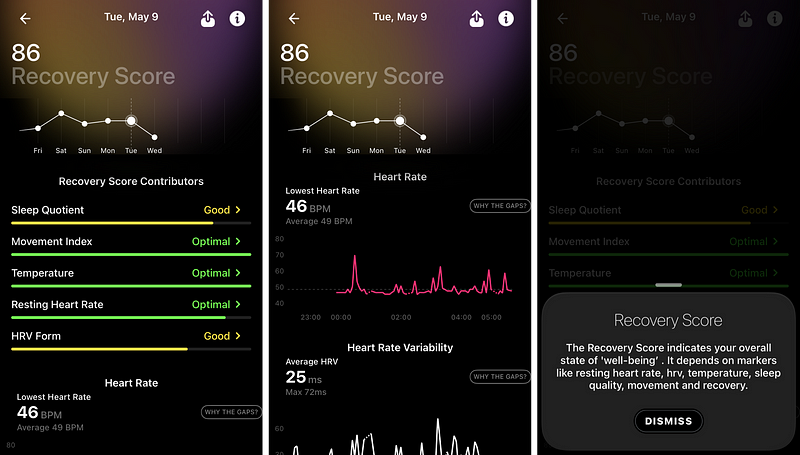
Sleep / Sleep Score
Ultrahuman estimates metrics similar to Oura, such as time in bed, time asleep, average HR and HRV, and then other attributes (see figure), from which it calculates a Sleep Score 1–100. Posts are clickable for more information.
Many people are interested in the hypnogram and the time spent in each stage of sleep. I’m compiling some summary data and I’m actually a little disappointed with the results compared to the Dreem2. I’m going to repeat myself, but determining sleep stages from the finger is a difficult discipline. And it’s also good to keep in mind that the quality of this data may be individual, the algorithm for calculating sleep stages may be more “skewed” towards people with lower HRV etc.
For Ultrahuman, I have chosen this night at random and give the Dreem2 values for it, as well as Oura (already with the new algorithm).
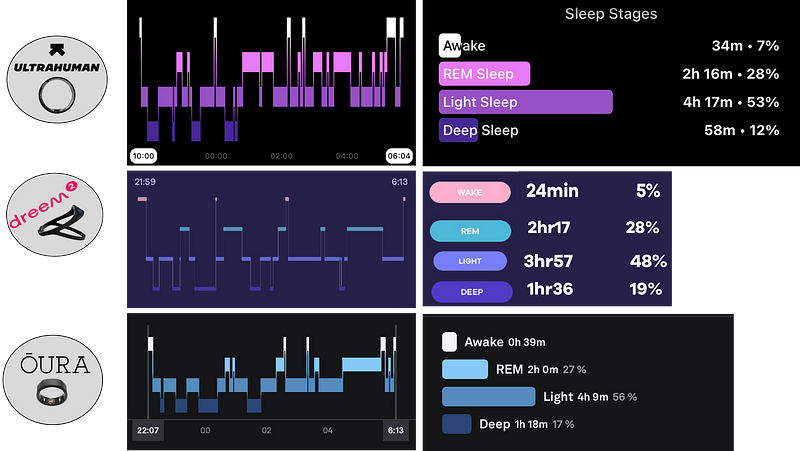
Actually, I would say that Ultrahuman’s hypnogram is quite reminiscent of the old Oura algorithm in its fragmentation.
💱 Ultrahuman is offering to buy out the “old” (R1, Oura 2, Oura 3) when you buy a new Air. The incentive price could probably be higher, but it’s an interesting move, especially for users who don’t like the Oura subscription concept.
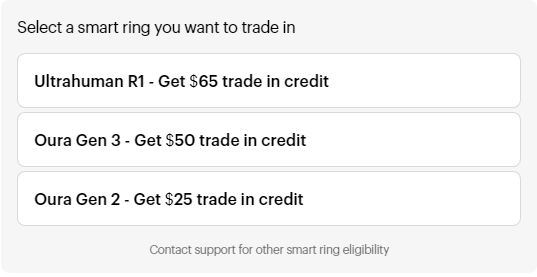
Interpretation & Data Quality
In the full review, I criticised RingConn for poor interpretation/translation of data into verbal form, which is a very welcome feature for a wide range of users. The leader in this area is Oura and its Readiness. The most interesting thing is usually to see how the algorithm handles verbal comments after a difficult night (illness, poor recovery due to external influences, etc.). The easiest way to simulate such a night is alcohol.
Once again, I took the opportunity to toast a few 🍺 equipped with Oura and Ultrahuman rings in the name of testing. Results the next day:
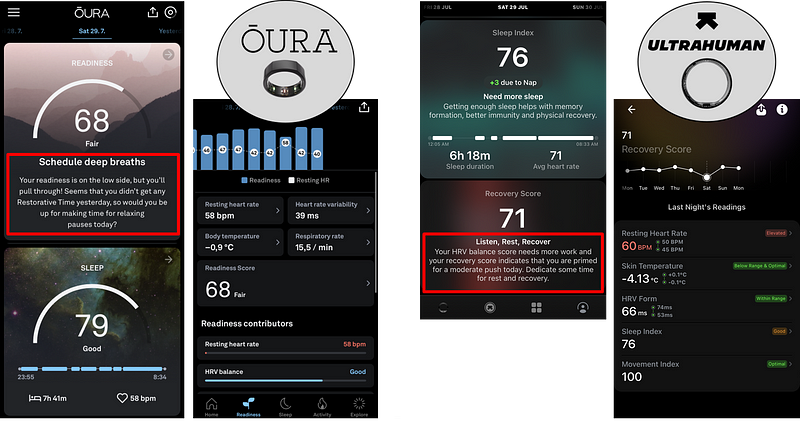
Both rings recorded mainly ⬆HR and ⬇HRV, and also less quality sleep. They drew similar conclusions and rested for a new day.
If you are observant, you may have noticed the differences in HR and especially HRV above. I would consider HR to be within a certain tolerance (2 bpm difference), but HRV in the example above differs by 27 ms. Why is this? I originally attributed the differences to a different HRV calculation (rMSSD vs. SDNN), but now both rings use the same pattern. What is different is the time window for the calculation. Oura uses the time of the entire sleep period, hence the AWAKE phase. Ultrahuman excludes this phase from the calculation.
Initially I had a problem with the different HRV values, but in the long term the values seem to match the trend of measurements from other devices, for example below is a comparison of the HRV trend from Oura and Ultrahuman.
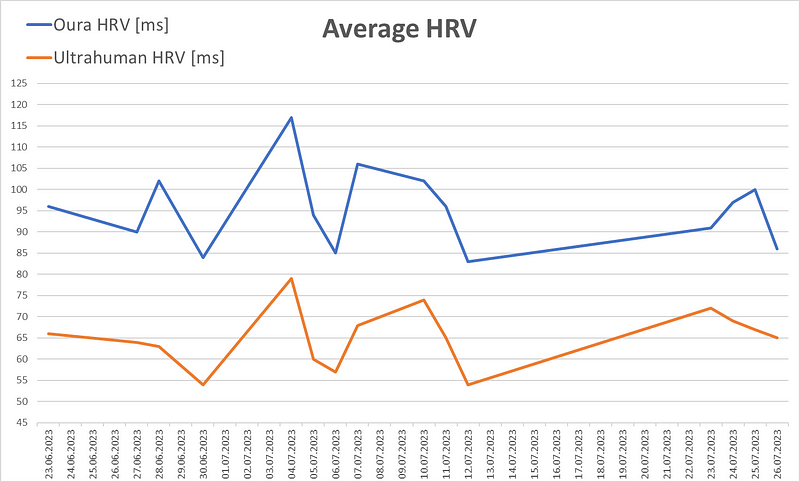
So if you were to switch from Oura to Ultrahuman, you might be surprised by this difference. However, in the longer term, the trend of the readings appears to be correct.
Further insights
In my first impressions I praised Ultrahuman for the human face of CS (Customer Service) and the transparent roadmap. This praise is still valid. Ultrahuman also has a good sense of humour.

I really like the last two SW innovations that change in the app during the day. The innovations are:
- Stimulant restriction window — where the app advises you when to enjoy caffeinated beverages.
- Recommendations for activities and light in relation to circadian rhythms.
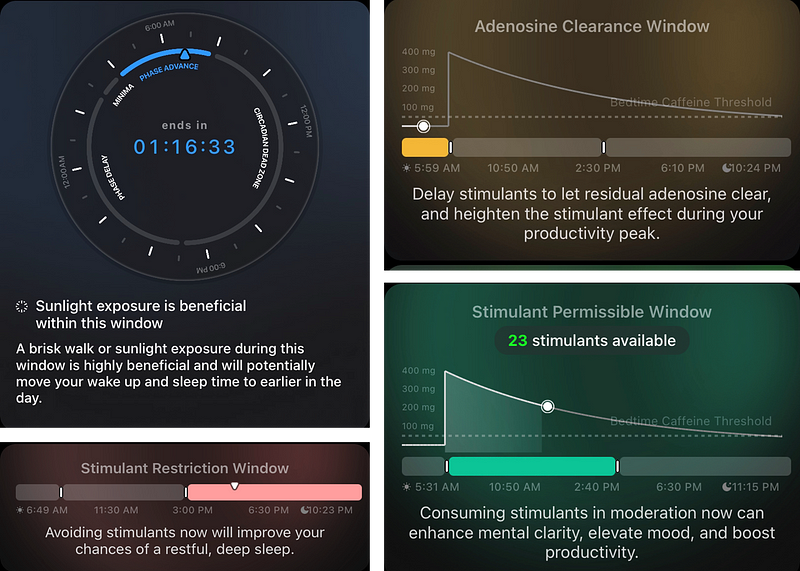
SW [-] & [+]
[+] 👍
- debugged application with the possibility of integration with CGM
- very fast synchronisation
- wide range of audio and video exercises, sessions, etc.
- biohacking features in the form of stimulus windows, light exposure recommendations, etc
- customer support
- no subscription model.
[-] 👎
- lack of Cloud environment/API,
- no prediction and period tracking functionality
- no user input/tagging option,
- absence of airplane mode.
Conclusion
The Air is a very well-made product and I have not found bottlenecks. It is very comfortable to wear, the ring is visually very nice (I like the matte black) and the millimeters saved on the width of the ring make it a little less “invasive” and “bulky”.
Personally, I wouldn’t invest in replacing the R1 with an Air, even though the grams and tenths are quite noticeable on the finger. It would make more sense for Ultrahuman to release the Air as a premium version to complement the existing R1 portfolio, especially now that they don’t have any other colour options (yet?). However, it looks like they’ve gone for a card that can also be redeemed for an Oura subscription.
Ultrahuman is a company founded by a group of biohackers. And it shows. A good example is the aforementioned tile for supplements and light exposure. These are 2 inconspicuous and actually simple functionalities, but they show that Ultrahuman thinks about health in a broader context. They also have the know-how, which can be experienced first-hand via the “Performance Couch” chat.
And I have to mention the AIR+M1 (CGM) ecosystem, those combinations of two different data sources that can bring interesting intersections in interpretation. I’ve already done a bit of testing in this combination and will share more in the future. By the way, Oura is partly responding to this by integrating with CGM applications (more here).
Ultrahuman Air is the next evolutionary step in smart ring development in terms of size and miniaturisation. The Swiss are preparing their Iris ring and I wouldn’t be surprised if Oura comes out with a new generation later this year.

OURA 3 –40–50 EUR DISCOUNT — https://fitnesator.link/oura
CIRCULAR RING 8% DISCOUNT — https://fitnesator.link/circular
RINGCONN DISCOUNT code 30 $ (PPM7D30L) — https://fitnesator.link/ringconn
ULTRAHUMAN AIR DISCONT CODE 10 % — https://fitnesator.link/ultrahuman
CODE: FITNESATOR10
